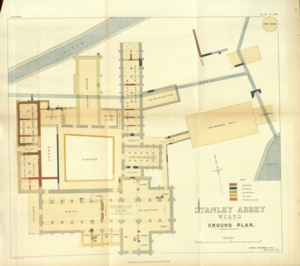| Monastery information | |
|---|---|
| Other names | St. Mary of Downfront |
| Order | Cistercian |
| Established | 1151 |
| Disestablished | 1536 |
| People | |
| Founder(s) | Empress Maud |
| Site | |
| Location | Bremhill, Wiltshire, England |
| Coordinates | 51°27′17″N 2°05′50″W / 51.45472°N 2.09722°W / 51.45472; -2.09722 |
| Visible remains | None |
| Public access | No |
Stanley Abbey was a medieval abbey near Chippenham, Wiltshire, England, which flourished between 1151 and 1536.
Foundation

The abbey was given by Empress Matilda in 1151 to monks from Quarr Abbey on the Isle of Wight. Originally at Loxwell, to the east of Chippenham, it moved to nearby Stanley in 1154. The abbey grew in size in the twelfth and thirteenth centuries, reaching a size of 450 acres (1.8 km) at its largest. Its influence also grew, Abbot Nicholas entertaining King John in October 1200 and in 1210 Abbot Thomas of Calstone attending the meeting of King John and the Cistercian abbots at York. In 1280 King Edward I gave stone to the abbey for a chamber to be built for his own use, and according to the abbey chronicle he made use of it in the spring of 1282. Princess Mary, the bishop of Salisbury and Edward II were all reported to have stayed at the abbey during the first years of the fourteenth century.
Its operation finally ceased as a result of the dissolution of the monasteries. The last abbot was Thomas Calne (also called Morley), and the abbey was dissolved in February 1536. Nothing now remains in situ except a green site on private property, but access may be obtained to visit it from Old Abbey Farm.
Subsequent history
At the dissolution the land passed into the possession of Sir Edward Baynton, who plundered the materials to build his manor house at Bromham. In 1864 the land was sold by John Bayntun Starky to Gabriel Goldney of Chippenham.
At various times since, remains such as burial places and a blacksmith's forge, as well as coins and tiles, have been found. Harold Brakspear's 1905 excavation discovered the layout of the monastery, including the church, infirmary and a dovecote.

Its original entrance now forms the gateway to Spye Park and is known locally as Spye Arch.
References
- Brakspear, Harold (1907). "The Cistercian Abbey of Stanley, Wiltshire". Archaeologia. 60: 493–516.
- ^ Pugh, R.B.; Crittall, Elizabeth, eds. (1956). "House of Cistercian monks: Abbey of Stanley". A History of the County of Wiltshire, Volume 3. Victoria County History. University of London. pp. 269–275. Retrieved 6 May 2021 – via British History Online.
- "Cistercian Abbeys: STANLEY". cistercians.shef.ac.uk. Retrieved 7 March 2009.
- "Bayntun History :: John Bayntun Starky 1834". www.bayntun-history.com. Retrieved 7 March 2009.
- ^ Historic England. "Stanley Abbey (212376)". Research records (formerly PastScape). Retrieved 6 May 2021.
- "Bayntun History – Spye Park House". Retrieved 11 January 2009.
External links
- "Extract from Records of Chippenham, F. H. Goldney, 1889". localhistory.co.uk. Retrieved 22 January 2010.